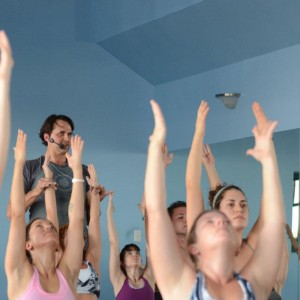Enlightenment Through Six Pack Abs: Moha Samadhi & Modern Yoga ~ Chris Kiran Aarya
 Recently my friend Marci Calabrese, an Albuquerque-based yoga teacher, heard from a young yoga teacher that: “Hot Yoga gets rid of love handles, give you a six pack, and then you become enlightened!”
Recently my friend Marci Calabrese, an Albuquerque-based yoga teacher, heard from a young yoga teacher that: “Hot Yoga gets rid of love handles, give you a six pack, and then you become enlightened!”
Wow, really? It’s that easy? Who knew?
Here in Germany there is a well known legend of the Pied Piper of Hamelin (Rattenfänger von Hameln) in which the children of a town were led away by a colorfully dressed piper, never to be seen again.
We often hear of false prophets and gurus being referred to as a Pied Piper, as someone leading people away to a dark place…which is usually disguised as something wonderful that really isn’t (kind of like the depiction of the 80′s in Hot Tub Time Machine).
While we are accustomed to personalizing the idea of a Pied Piper, since it seems easier to put a face to it, we should remain aware that being lured by the seeming ease or attraction of a false path can have the same effect on us.
Moha (delusional) Samadhi is the enlightenment of ignorance. It leads the ignorant into darkness and into the abode of Lord Yama, the god of death. And in his underworld he keeps the masses chained to the wheel of death and life.
I define Yoga the way the early authors to whom it was revealed describe it; as a way to transform my soul, expire my karmas, and unify with the divine.
Here in the middle of the Kali-Yuga, more people than ever are practicing or just discovering Yoga all over the world – which is a good thing. At the same time, so much of the practice being shared has been stripped of its spiritual core, leaving only a set of calisthenics bearing Sanskrit names or worse yet, body worship disguised as spirituality. Its an easy age in which to lose our way and unwittingly end up following the Pied Piper of Moha-Samadhi.
“The world is a panorama of endless movement, a vast assemblage of rainbow colors. If upon seeing it, people think that they have really attained something permanent, or become intoxicated with the colors, they will make a great mistake. People are attracted to minute portions of this earth, and embracing them, seek the path of self-gratification. But long before they attain satisfaction, those minute portions, those colors, vanish into nothingness, leaving them in endless frustration and lamentation, like blind, headless demons. This is not a decree of God, it is the law of the universe.” ~ Anandamurti
If you are on a spiritual path in which you are not challenged at your core, that fundamentally changes you, you are probably not on the right path. If it feels too easy you must ask yourself if you are on the path to moha-samadhi.
(Hint, if your practice is chocolate cake, savasana, and snorting lines of affirmations of how great you are—you’re probably in the fast lane to Moha-Samadhi).
If instead of surrendering to the practice and letting it transform you, you change the practice to suit your comfort and desires, you are modifying the practice to serve your ego and thus probably on the path to Moha-Samadhi.
If you simply take something that brings you pleasure and comfort and decide to call it your spiritual path, you are on the path of Moha-Samadhi. Sure, yoga can bring great comfort, but only when we sincerely challenge ourselves to transform.
It is expecting bliss from something other than the self.
During the Kali-Yuga, its easy to identify yourself as your body since every message from the samsaric world tells you that you are your body. Your body is something to be worshiped, sculpted, exalted, and clad in the latest (and hottest) yoga fashions. And when your body dies, the message is that you die with it.
Sure, asana practice is for many the gateway to the practice of yoga, but its not without the danger of starting to think you are your body—and never moving beyond the lowest form of yoga: hatha.
In Hatha-Yoga, the first step is to be in the body and to experience it fully. The next step of Hatha-Yoga is to realize that you are not the body. But in this process, its easy to get sidetracked, deluded into thinking you are the body and becoming obsessed with exalting it, rather than experiencing the energy of your subtle body, peeling back the layers of mind and ego to find the Self.
We are also lured onto the path of moha-samadhi when we see ourselves as our thoughts and our ego. So, before we congratulate ourselves on realizing we are not our body (put the party hats away for now—we’ve got work to do!), we move on to a much greater challenge of realizing we are not our mind.
“You can’t think yourself out of a prison made of thoughts.” ~ Krishna Das
This is why meditation can be such a challenge, especially during the Kali-Yuga. We are being bombarded with constant messages and interactions (computers, and cell phones) that can deliver a dopamine jolt that make them hard to resist. Meanwhile, your ego is chattering away like a monkey in a tree passing out bad advice on why you should feel jealous of your friend’s hot new shoes or to be concerned about what the neighbors think (they’re not thinking about you anyway—they’re thinking about themselves). Hey, nobody said this was going to be easy!
But in realizing we are not our mind, we don’t want to suppress these thoughts and ego messages but to release them by faithfully returning to our practice again and again. Besides, trying to suppress your thoughts is like trying to give your cat a bath or to tell a person who is upset to “calm down”— its not likely to work.
Another path to Moha-Samadhi is to narcotize yourself with drugs, sex outside of love, spending countless hours watching TV or surfing the internet, or anything which keeps you distracted from being able to live as your true self. And yes, I get the irony that you’re reading this on your computer or smartphone.
“Bliss is easy, just take a drug. What is hard is feeling good about our real selves.” ~ Krishna Das
And don’t get me wrong, I love comfort and desire as much as anyone. But making these two things your primary goals in life, and seeing them as your path to the brahma-loka, is to be on the path to Moha-Samadhi. I’m not advocating flogging yourself every day with a bag of oranges (which could be messy, expensive, and a waste of good oranges) but don’t shy away from the real transformative work that is at the heart of the practice.
It’s a challenge to embrace joy and desire in this world but not to become a desire junkie and let yourself be led off on a path to Moha-Samadhi.
What does the path of Moha-Samadhi look like in our everyday life?
It is in thinking that getting a great looking butt is your path to salvation instead of embracing your asana practice but realizing that its just the first step on the path.
It is living on affirmations but never exercising discernment and challenging yourself to examine and learn to love your shadow side.
It is thinking that choosing the path of pleasure-seeking and narcotizing ourselves is the same thing as staying true to a sincere spiritual practice.
It is taking what you are attracted to, what feels good, and calling it our spiritual path; changing the practice in order to suit our desires, compulsions, and comfort instead of being transformed by the practice.
“When we resist the change that’s inevitable, we miss the change that’s possible” ~ Leslie Kaminoff
Sometimes even well intentioned people are leading people on this path and you may choose to challenge them. But in doing so, beware—armies of the unconscious will attack those who call for discernment. Moha-Samadhi has an excellent defense mechanism and why not? Those who have chosen the path of comfort and desire as their guiding beacons are loathe to give up the intoxicating path they have chosen.
How to Stay On The Path
First off, let me make it clear that this is a challenge for me too—after all I’m in a human body and have a mind with an ego and intellect so I have all of the same challenges.
Secondly, realize that living in the Kali-Yuga can be a real challenge to staying on the path. As its is written in the Bhagavata Purana, the Kali-Yuga is “when the good suffer endlessly, and the evil are exhilarant. The earth is full of sin. All that is sacred disappears from the world of men; no one cares. In this age things lose their innate grace. ”
But the Kali Yuga is also a time when liberation is closer than ever, as the Bhagavata Purana says; “Those who say the Kali Yuga is an age of evil forget that this wonderful age is the yuga when moksha is nearest.”
So…
Find a teacher, a guru—one with an authentic lineage and a lifelong practice, one who lives the practice, not just teaches it. Open yourself to a practice which challenges you; be it bhakti, meditation, scriptural study, or even the faith your parents shared with you.
“Look for those qualities in your guru which you would eventually like to realize yourself.” ~ Brenda Feuerstein
Practice.
And keep coming back to your practice.
Don’t give up because you missed a day or a week. We have responsibilities, bills to pay and families to care for. The practice is the one responsibility we owe to ourselves. And it is always patiently waiting within us.
Exercise discernment.
Discernment is the first casualty of the Kali Yuga so expect yours to be constantly challenged. There won’t be a day when the intoxicating siren call to the path of Moha-Samadhi will not be present and it can be a brilliant master of disguise. So, check in frequently in the practice svadhyaya (self examination), be honest with yourself, and find your way back to your true path. Oh, and don’t beat yourself up if you get sidetracked—it happens to all of us.
“We learn to be flexible and open to life, so that we can continue to learn and grow on the basis of our new outlook. Openness should never be indiscriminate but be based on proper discernment.” ~ Georg Feuerstein, Ph.D.
Keep good company. Surround yourself with those who will support your practice and not constantly pull you away from it. While you’re at it, do your best to be that good company for others. The ultimate expression of love is to support another being’s path toward union with the divine.
Keep the faith. The path toward union with the divine, Yoga, is a discipline but not without joy. Once we realize that life in this human form is meant to be a challenge, and fully accept difficulty as natural and normal, we cease to be offended or daunted when we encounter a struggle or a test to our practice.
Recognize that when someone attacks you and hurts you, they are attacking your ego. Don’t let them. Every attack is an opportunity to realize that everything that can be hurt, the body, mind and ego, is not the true Self. The true Self is eternal and unchanging, it is beyond injury or pain, because it is bliss.
Comfort does not transform you, challenge does.
By embracing these experiences, we allow ourselves to find peace within our difficulties rather than wasting our energy trying to escape them so we can lay in a hammock we convince ourselves is a practice. We can embrace these challenges joyfully as opportunities to expire our karmas and keep on our path to union with the divine.
Be free and realize that you don’t need to make yourself happy—your true self already is.



